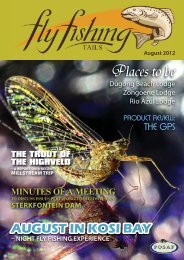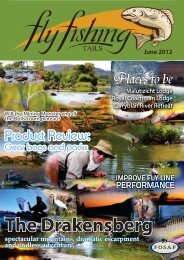MAURITIUS - Flyfishingtails
MAURITIUS - Flyfishingtails
MAURITIUS - Flyfishingtails
You also want an ePaper? Increase the reach of your titles
YUMPU automatically turns print PDFs into web optimized ePapers that Google loves.
Mauritian Climate<br />
Situated near the Tropic of Capricorn, Mauritius has the advantage<br />
of a subtropical climate. The climate is fairly acceptable to everyone<br />
and the heat is never unbearable.<br />
There is a warm, dry winter from May to November and a hot, wet,<br />
and humid summer from November to May. The temperature on the<br />
coastal areas varies between 22°C in winter and 34°C in summer. The<br />
sea temperature varies between 22°C and 27°C. In the central part<br />
of the island, the maximum daytime temperature varies from about<br />
19°C in August to about 26°C in February. The western and northern<br />
regions are warmer and relatively drier than the East and the South.<br />
The Cyclone season generally occurs between January to March.<br />
Tropical cyclones are a common occurrence in Mauritius and tend to<br />
disrupt the weather for only about four days per year bringing a lot<br />
of rain in the region.<br />
The sun rises at 5.00am and sets at 7.00pm in Summer and in Winter,<br />
rises at 6.00am and sets at 6.00pm.<br />
Mauritius is the most developed of the Mascarene Islands, but with<br />
a bit of effort and resourcefulness you can escape the crowds and<br />
find your own patch. The smells, noises and bustle of the mercantile<br />
capital Port Louis, Africa’s wealthiest city, are never far away.<br />
The island of Mauritius is also well known for its production of rum,<br />
derived from the sugar cane that forms 90% of the islands agricultural<br />
crop, as well as being renowned for having been the only<br />
known home of the dodo.<br />
The Bonefish (Albula Vulpes)<br />
There is not really anything new to say about bonefish except to<br />
confirm that all the hype is for real. Where do you go in fly fishing<br />
challenges after trout, well...bonefish.<br />
Bonefish are by far the most popular and exciting light tackle<br />
inshore species available to fly anglers. Its blistering run melts off<br />
backing, sending it ripping across shallow flats creating a jet like<br />
sound as its mercury silver body bounces light off the tropical skies.<br />
The magic of landing your first ever large bone is<br />
a similar feeling to the first 3kg plus trout except<br />
the gear is heavier, the water warmer and the<br />
fight is longer and harder.<br />
It is hard to imagine being spooled on an 8<br />
weight with 300m of backing on 10lb fluro tippet.<br />
The places where bonefish live are magical and<br />
the opportunity to fish for them should not be<br />
missed. Bonefish flies vary with location, water<br />
depth, current speed, size of fish and the fishes<br />
feeding pattern.<br />
Did you know?<br />
The air quality in Mauritius is one<br />
of the best in the world. Mauritius<br />
ranked second in an air quality<br />
index released by the World Health<br />
Organization (OMS).<br />
St Brandon’s undoubtedly holds the best bone fishing in the world.<br />
Huge numbers of bonefish inhabit these flats with the average size<br />
of the fish being 6lbs and plenty fish between 8lbs and 10lbs. A<br />
day with close to 50 bonefish is not uncommon in the St Brandon’s<br />
atolls, with fish in the ten pound plus range being frequently<br />
spotted.<br />
Techniques<br />
There is not really anything<br />
new to say about bonefish<br />
except to confirm that all the<br />
hype is for real. Where do you<br />
go in fly fishing challenges<br />
after trout, well...bonefish.<br />
When choosing a reel, one should look for a high quality saltwater<br />
reel with a smooth drag that can fit a full weight forward warm<br />
saltwater floating line to match the weight of the rod, together with<br />
about 250 yards of 20-30 lbs backing. Use tapered leaders ranging<br />
from 9 - 12 foot with a tippet breaking strength of 15lbs.<br />
All fishing is done by wading on the flats and sight casting to<br />
bonefish. They are spotted with the help of a good pair of polarized<br />
glasses. The fish are led by a couple of feet so you don’t spook<br />
them and short sharp erratic strips are best. The hook must be set<br />
by a light line strike as well as a side movement of the rod. The hook<br />
point penetrates far better than a lifting rod strike and results in less<br />
fish being lost.<br />
Fishing for bonefish at St Brandon’s can at times be ridiculously easy<br />
and at other times more challenging, so casts can range anything<br />
from 10 feet to 110 feet.<br />
7<br />
Garreth Coombes with<br />
a monster bonefish







